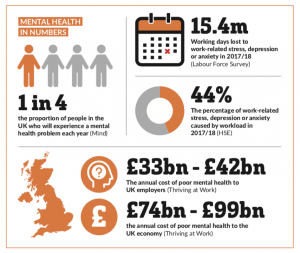With stigmas around mental health evaporating, more employees feel comfortable talking about their own problems in the workplace. While this is a major step forward, there’s still plenty of uncertainty around how to support those seeking further assistance.
This was highlighted by research by mental health charity Mind. It found that 56 per cent of employers would like to do more to improve staff wellbeing but, as they lacked the right training or guidance, they didn’t know where to start.
Against a backdrop of increasing stress levels, helping employers to take these first steps is a must. Aon Employee Benefits head of health management Charles Alberts says: “Last year (2017/18) the Health & Safety Executive recorded 595,000 cas
Pressure gauge
All sorts of factors are driving up stress levels in the workplace. For starters, the current political and economic climate is creating a lot of uncertainty for business owners and their employees. “Brexit is very unsettling,” says Towergate Health & Protection head of proposition development David Prosser. “No one really knows how it will affect businesses and jobs.”
Changes in working practices are also contributing to stress levels. Although workload remains the number one cause of stress according to HSE statistics, the growth of remote working creates new pressures, with employees at risk of feeling isolated and unsupported.
Similarly, the ‘always on’ culture puts additional stresses on employees. “It can be very difficult not to look at work emails in the evening or at weekends,” says RedArc managing director Christine Husbands. “Receiving bad news or a demand for a piece of work can ruin an evening, affecting an employee’s sleep, relationships and mental wellbeing.”
Changes in workplace demographics also bring challenges. Husbands says that with a broader spread of ages in the workplace, employers are having to deal with different attitudes, concerns and requirements. “The stresses of a 21-year-old starting their career with university debt are very different to those of a 65-year-old having to care for a partner or parent,” she adds. “Employers need to take all of these factors into account when supporting their staff.”
Signs and symptoms
Whatever the cause, mental ill health can manifest itself in a number of ways in the workplace. Warning signs can include poor concentration, low mood, tearfulness and irritability, and avoiding social activities.
Monitoring usage on the employee assistance programme (EAP) or keeping tabs on sickness rates is one way to track problems. Increases in absence can be a key indicator, with research by Mind finding that 21 per cent of employees have called in sick to avoid work.
Some indicators are less obvious. Presenteeism, where employees are in the workplace but functioning below par due to illness, can be more difficult to spot.
In addition, and partly driven by the always on culture, leavism is plaguing more and more organisations. “It can be a battle to switch off,” says Alberts. “Employees increasingly feel they need to check emails outside of normal hours but a psychological break from work is invaluable. Employers must recognise this issue and take steps to prevent it.”
Workplace culture is key to stamping out this behaviour. Email policies discouraging out-of-hours use coupled with good examples from line managers can set expectations and help employees feel they can switch off.
Support strategy
Having the right workplace culture will also ensure employees feel their employer cares about their mental health and encourage them to seek support if they do have a problem. “It’s so important,” says Bupa Global commercial director Patrick Watt. “Senior leadership has to set the tone within an organisation.”
Plenty of benefits and services are available that can provide a robust support network. “Having an EAP used to be the answer,” says Prosser. “Today, employers should be looking at a multi-layered strategy with services to treat mental health problems as well as to help prevent them.”
On the treatment side, an EAP, especially where it includes access to counselling, is still a valuable tool. Offering access to. services such as EAPs through apps can help to increase usage. “It’s much more discrete to access a service on a smartphone,” says Teladoc Health chief engagement officer Stephany Verstraete. “This is great for employees who might shy away from asking someone else for help.”
Medical insurance can also provide treatment, with many of the insurers extending their mental health support over the last few years. For example, in 2018 Bupa added its Business Mental Health Advantage to its group schemes. This extends cover for mental health conditions, including ones typically excluded such as alcohol and drug abuse; removing time limits on treatment so chronic conditions are covered; and providing ongoing support for the monitoring and maintenance of diagnosed conditions.
To help prevent problems, employers also need to include benefits that support mental health and wellbeing. Watt says this is where it gets more complex. “Everyone is different so there’s no silver bullet when it comes to preventing mental health problems,” he explains. “An employer’s strategy could include mindfulness, physical activity, social interaction, giving and learning. Anything that helps to create an environment where employees can thrive.”
Benefit delivery
Although a mental health strategy can involve a broad array of products, Alberts says that many employers will already have some of these as added value services on group risk and healthcare products. “Employers need to be proactive and look at the services they already have,” he says. “Many will provide monthly wellbeing content that can be used as a basis for a mental health strategy.”
Charities such as Mind, Mental Health Foundation and Mental Health First Aid England can also provide valuable content and support. Likewise, the Health & Safety Executive can provide guidance on tackling work-related stress and supporting employees with mental health conditions.
But with so many products and services potentially fitting under the mental health and wellbeing banner, there’s the potential for confusion. As accessing the right service as quickly as possible can make a significant difference to the outcome, Husbands says employers should consider some form of triage service. “Our mental health nurses will speak to an employee to determine the nature of the problem and the most appropriate treatment,” she explains. “Mental health is so complex and individual.”
The importance of this approach is also recognised by Teladoc Health. Its Mental Health Navigator, which is already available in Australia and Canada, is launching in the UK later this year, provides employees with access to a doctor who will make a diagnosis and then guide them along the most appropriate treatment pathway. “Where employees have this level of support, they are much more likely to stick with the treatment,” adds Verstraete.
And, with mental health finally receiving the acceptance it needs, putting together an effective package of support for employees’ mental health and wellbeing is a must.
